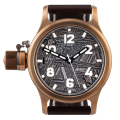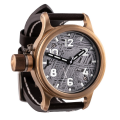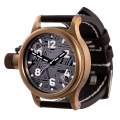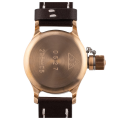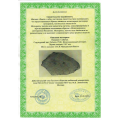AGAT 295 Bronze 46 mm Meteorite Seymchan
- Case diameter
- 46 mm
- Case material
- Bronze
- Dial
- Seymchan Meteorite, Luminous dial
- Crystal
- Sapphire crystal
- Water resistance
- 750 meters
- Functions
- Hours, minutes, seconds
- Movement
- Mechanical
- Automatic movement
- Yes
- Weight (without straps)
- 150 grams
- Measurements
- 60х17х62 mm
- Manufactured in
- Russia
- Manual assembly
- Yes
- Product notes
- The norm is a patina coating of the surface - a coating layer of various copper oxides, mainly greenish color
Features
Reviews
Leave a reviewAbout Seymchan Meteorite
Brief description:
Type: stony-iron meteorite, class pallasites
Place of fall: Russia, Magadan region
Time of fall: not recorded
Time of discovery: 1967
History of discovery
In June 1967, during geological exploration of one of the tributaries of the Hekandue River, near the village of Seymchan in the Magadan region, geologist Fyodor Mednikov noticed an unusual large stone of irregular shape. A shiny metal block, weighing 272 kg, was laying in a dry river bed and used to be constantly exposed to streams of water carrying sand and pebbles. It was due to this effect, which for many years polished the surface of the mysterious stone, that it became noticeable to a trained eye.
Mednikov reported his discovery to the Committee on Meteorites of the USSR Academy of Sciences and sent there a small sample, the extraterrestrial nature of which was quickly confirmed. Scientists went to the site, examined the stream bed with a mine detector and found another fragment weighing 51 kg 20 meters from the first find.
The meteorite was named Seymchan, in honor of the village near which it was found, classified as iron, and this concluded the research - iron meteorites are not so rare, and scientists are no longer particularly interested.
By the way, giving meteorites names associated with the name of the object closest to the fall site is a common practice. Thus, the famous Tunguska meteorite was named in honor of the Podkamennaya Tunguska River, and one of the latest, but no less sensational, Chelyabinsk - in honor of the regional center Chelyabinsk, over which it flew in February 2013.
The history of the Seymchan meteorite unexpectedly continued in 2004, when several more fragments weighing about 50 kg were found during a new expedition. About 20% of them contained olivine grains. Repeated studies and comparisons of the composition of new and old samples were conducted. Based on the results of these studies, Seymchan was identified as a palassite of the main group - one of the rarest types of meteorites.
Age and size
The Seymchan meteorite is a fragment of one of the ancient protoplanets that arose and collapsed at the dawn of the formation of the Solar System. The heterogeneity of its structure and iron-olivine composition are characteristic of the boundary layers between the core and mantle of a large celestial body. Only 38 such finds are known worldwide. Such origin also indicates a solid age – 4-4.5 billion years.
The exact time of Seymchan's fall to Earth is very difficult to estimate. Most likely, it happened between 100 000 and 200 000 years ago, with a high probability during the last ice age. A space object weighing about 60 tons entered the Earth's atmosphere and crumbled into many fragments over an area of 15 square kilometers.
Description
The chemical composition of Seymchan: iron 80-90%, nickel 9.15%, there are admixtures of iridium, gallium and germanium. The metal sections of the meteorite have a clearly visible pattern of Widmanstätten lines. Such a pattern is formed during the cooling and crystallization of the iron-nickel matrix in space conditions over many millions of years. It is very beautiful and resembles the pattern of icy frost on a winter window.
